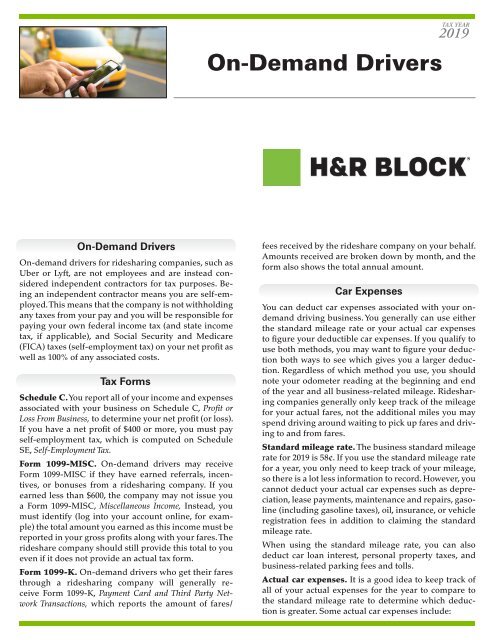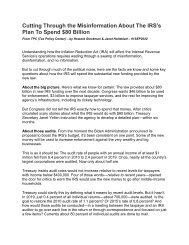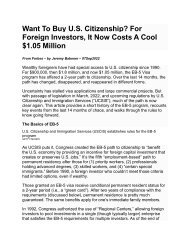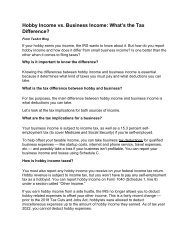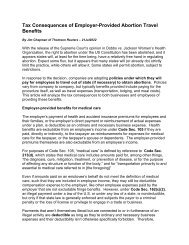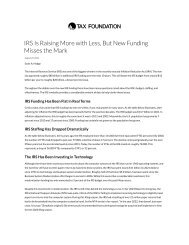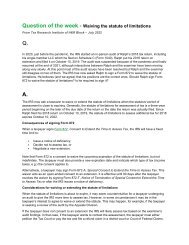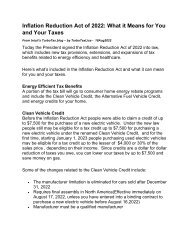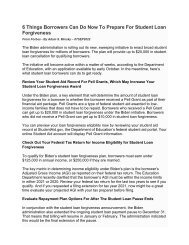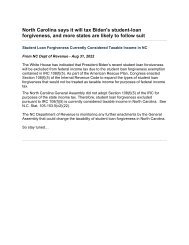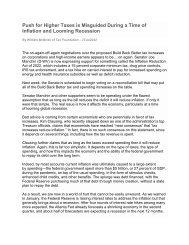You also want an ePaper? Increase the reach of your titles
YUMPU automatically turns print PDFs into web optimized ePapers that Google loves.
<strong>On</strong>-<strong>Demand</strong> <strong>Drivers</strong><br />
TAX YEAR<br />
2019<br />
<strong>On</strong>-<strong>Demand</strong> <strong>Drivers</strong><br />
<strong>On</strong>-demand drivers for ridesharing companies, such as<br />
Uber or Lyft, are not employees and are instead considered<br />
independent contractors for tax purposes. Being<br />
an independent contractor means you are self-employed.<br />
This means that the company is not withholding<br />
any taxes from your pay and you will be responsible for<br />
paying your own federal income tax (and state income<br />
tax, if applicable), and Social Security and Medicare<br />
(FICA) taxes (self-employment tax) on your net profit as<br />
well as 100% of any associated costs.<br />
Tax Forms<br />
Schedule C. You report all of your income and expenses<br />
associated with your business on Schedule C, Profit or<br />
Loss From Business, to determine your net profit (or loss).<br />
If you have a net profit of $400 or more, you must pay<br />
self-employment tax, which is computed on Schedule<br />
SE, Self-Employment Tax.<br />
Form 1099-MISC. <strong>On</strong>-demand drivers may receive<br />
Form 1099-MISC if they have earned referrals, incentives,<br />
or bonuses from a ridesharing company. If you<br />
earned less than $600, the company may not issue you<br />
a Form 1099-MISC, Miscellaneous Income, Instead, you<br />
must identify (log into your account online, for example)<br />
the total amount you earned as this income must be<br />
reported in your gross profits along with your fares. The<br />
rideshare company should still provide this total to you<br />
even if it does not provide an actual tax form.<br />
Form 1099-K. <strong>On</strong>-demand drivers who get their fares<br />
through a ridesharing company will generally receive<br />
Form 1099‐K, Payment Card and Third Party Network<br />
Transactions, which reports the amount of fares/<br />
fees received by the rideshare company on your behalf.<br />
Amounts received are broken down by month, and the<br />
form also shows the total annual amount.<br />
Car Expenses<br />
You can deduct car expenses associated with your ondemand<br />
driving business. You generally can use either<br />
the standard mileage rate or your actual car expenses<br />
to figure your deductible car expenses. If you qualify to<br />
use both methods, you may want to figure your deduction<br />
both ways to see which gives you a larger deduction.<br />
Regardless of which method you use, you should<br />
note your odometer reading at the beginning and end<br />
of the year and all business-related mileage. Ridesharing<br />
companies generally only keep track of the mileage<br />
for your actual fares, not the additional miles you may<br />
spend driving around waiting to pick up fares and driving<br />
to and from fares.<br />
Standard mileage rate. The business standard mileage<br />
rate for 2019 is 58¢. If you use the standard mileage rate<br />
for a year, you only need to keep track of your mileage,<br />
so there is a lot less information to record. However, you<br />
cannot deduct your actual car expenses such as depreciation,<br />
lease payments, maintenance and repairs, gasoline<br />
(including gasoline taxes), oil, insurance, or vehicle<br />
registration fees in addition to claiming the standard<br />
mileage rate.<br />
When using the standard mileage rate, you can also<br />
deduct car loan interest, personal property taxes, and<br />
business-related parking fees and tolls.<br />
Actual car expenses. It is a good idea to keep track of<br />
all of your actual expenses for the year to compare to<br />
the standard mileage rate to determine which deduction<br />
is greater. Some actual car expenses include:
Powered by TCPDF (www.tcpdf.org)<br />
• Depreciation.<br />
• Licenses.<br />
• Gas.<br />
• Oil.<br />
• Car washes.<br />
• Lease payments.<br />
• Insurance.<br />
• Garage rent.<br />
• Parking.<br />
• Air fresheners.<br />
This brochure contains general information for taxpayers and<br />
should not be relied upon as the only source of authority.<br />
Taxpayers should seek professional tax advice for more information.<br />
Copyright © 2019 Tax Materials, Inc.<br />
All Rights Reserved<br />
<strong>On</strong>-<strong>Demand</strong><br />
<strong>Drivers</strong><br />
• Registration fees.<br />
• Repairs.<br />
• Tires.<br />
• Tolls.<br />
• Cleaning supplies.<br />
If you use your car for both business and personal purposes,<br />
you must divide your expenses between business<br />
and personal use. You can divide your expenses based<br />
on the miles driven for each purpose.<br />
In order to take actual expenses, you need to keep track<br />
of all expenses related to your car and related receipts.<br />
Other Business Deductions<br />
In addition to car expenses, you may incur some other<br />
common operating expenses you can deduct to offset<br />
your income. You can deduct an expense if it is both ordinary<br />
and necessary. An ordinary expense is common<br />
and accepted in your particular line of work. A necessary<br />
expense is helpful and appropriate for work. An<br />
expense need not be required to be considered necessary.<br />
Even though an expense may be ordinary and necessary,<br />
the cost may not be deductible.<br />
Office expenses. If you keep a log book of your work,<br />
the amounts you spend for a notepad, pen, paper, etc.<br />
could be a deductible business expense.<br />
Legal and professional services. The amount you pay<br />
for legal or professional help (including tax preparation)<br />
could be a deductible business expense.<br />
Refreshments. If you provide refreshments exclusively<br />
available to your riders, such as gum, snacks, or a cooler<br />
full of bottled water or soda, the amount you spend on<br />
those items can be deducted as a meals expense. Meals<br />
are subject to a 50% limitation.<br />
Cell phone. As an on-demand driver, you generally receive<br />
fares through an app on your cell phone. If you use<br />
your cell phone for personal and business use, the cost<br />
of your cell phone and service should be prorated. If you<br />
use a second cell phone exclusively for your business,<br />
then 100% of its cost and service may be deductible.<br />
Service fees. Most ridesharing companies charge a service<br />
fee for each fare. Service fees are generally taken<br />
out of the total fare price and the driver receives the remainder<br />
amount. You can deduct the amount of service<br />
fees you paid during the year.<br />
Interest on car loan. If you own your car (not leased)<br />
you can deduct the part of your car loan interest that<br />
represents your business use of the car. You cannot deduct<br />
the part of the interest expense that represents<br />
your personal use of the car.<br />
Personal property taxes. You can deduct the business<br />
percentage of state and local personal property taxes<br />
paid for your vehicle. The personal portion of personal<br />
property taxes is deductible if you itemize.<br />
Example: Holly is a part-time driver for Uber who uses the<br />
standard mileage rate. In 2019, her total fare trip mileage is<br />
420 miles, but she actually drives 525 total miles related to<br />
her business. She pays $50 in tolls while driving. The business<br />
percentage of her annual cell phone expense is $198.<br />
Holly provides refreshments (bottled water, soda, snacks) to<br />
her riders for a total cost of $100. She receives Form 1099-K,<br />
which shows her total income (fares/fees) as $2,112. She also<br />
receives $85 in referral bonuses from Uber and pays Uber service<br />
fees totaling $375.<br />
Income<br />
Expenses<br />
• Fares: $ 2,112<br />
• Mileage: $ 305 (525 × 58¢ per mile)<br />
• Referral bonuses: $ 85 • Cell phone: $ 198<br />
• Refreshments: $ 50 (50% of $ 100)<br />
• Tolls: $ 50<br />
• Uber service fee: $ 375<br />
Total income: $ 2,197 Total expenses: $ 978<br />
Holly’s net profits are $1,219 ($2,197 – $978). Assuming she<br />
is in the 10% federal tax bracket and 4% state tax bracket, her<br />
total taxes for her part-time driving business are listed below.<br />
Federal income tax................................................................... $122<br />
State income tax......................................................................... $49<br />
Self-employment tax............................................................... $172<br />
Total taxes..................................................................................... $343<br />
Contact Us<br />
There are many events that occur during the year that can affect<br />
your tax situation. Preparation of your tax return involves summarizing<br />
transactions and events that occurred during the prior<br />
year. In most situations, treatment is firmly established at the<br />
time the transaction occurs. However, negative tax effects can<br />
be avoided by proper planning. Please contact us in advance<br />
if you have questions about the tax effects of a transaction or<br />
event, including the following:<br />
• Pension or IRA distributions.<br />
• Significant change in income or<br />
deductions.<br />
• Job change.<br />
• Marriage.<br />
• Attainment of age 59½ or 70½.<br />
• Sale or purchase of a business.<br />
• Sale or purchase of a residence<br />
or other real estate.<br />
• Retirement.<br />
• Notice from IRS or other<br />
revenue department.<br />
• Divorce or separation.<br />
• Self-employment.<br />
• Charitable contributions<br />
of property in excess of<br />
$5,000.


